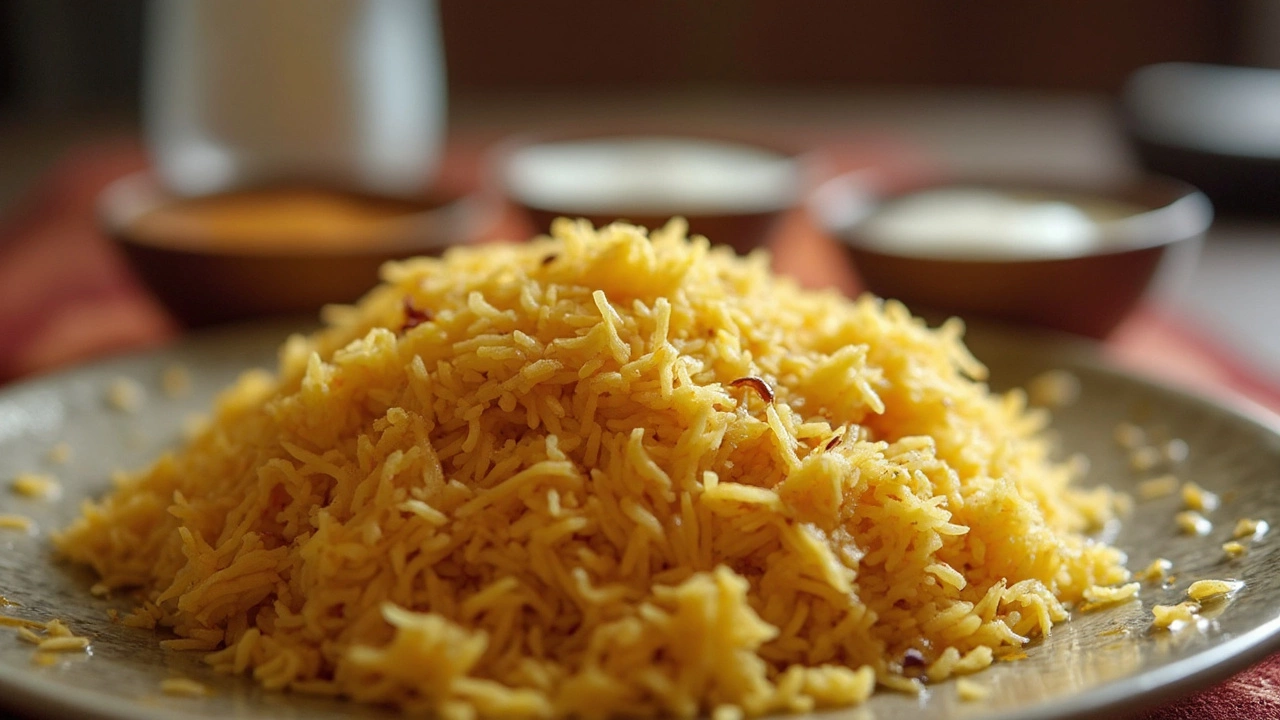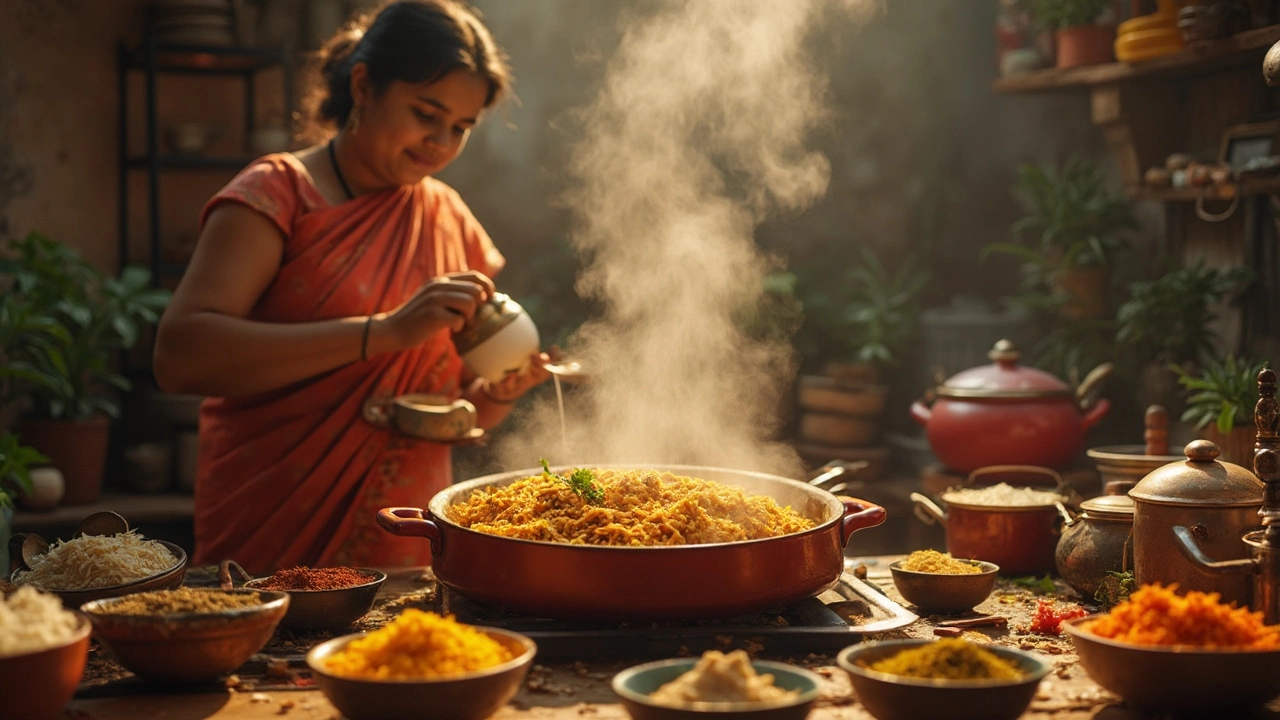Ever looked at a biryani recipe and paused at the step where it says 'pour in some milk'? You're not alone. Lots of home cooks scratch their heads at this point, wondering what difference a splash of milk could possibly make in a dish packed with bold spices and slow-cooked meat or veggies.
Here's the secret: that small addition of milk isn’t just for taste. It brings out the color in saffron, helps spices blend, and even makes the rice softer and fluffier. If you’re used to dry or uneven biryani, a little milk in the layering process changes everything. Plus, it connects the flavors so every bite feels richer and just a bit more special—like the restaurant-style biryani people rave about!
- Where the Milk Tradition Started
- Science Behind Creamy Rice
- Types of Milk and Their Impact
- Common Mistakes to Avoid
- Pro Tips for Better Biryani
Where the Milk Tradition Started
Biryani came to India with Persian and Central Asian cooks long before it turned into the comfort food we know today. In these long-ago royal kitchens—think Mughal emperors and Nawabs—cooks combined rich flavors to impress their guests. That’s where you start seeing dairy, especially milk and cream, showing up in recipes. A little milk mixed with saffron was often used to tint rice golden yellow and add a subtle, luxurious flavor. It wasn’t just for looks, either. Dairy brought balance to all those hot spices and tangy yogurt.
If you check out traditional Hyderabadi or Lucknowi biryani recipes, you’ll find milk in the ingredient list more than you’d expect. Even today, chefs in places like Old Delhi stick to this old trick. Most of these recipes pair milk with high-grade basmati rice and aromatic spices—all about creating a dish that’s classy and crave-worthy.
Here’s a quick breakdown of where milk fits in with other common biryani ingredients, especially in classic North Indian and Mughal-style dishes:
| Region/Style | Main Dairy Used | Role in Biryani |
|---|---|---|
| Hyderabadi | Milk, Yogurt | Softens rice, balances heat, boosts aroma |
| Lucknowi (Awadhi) | Milk, Cream | Adds creaminess, lifts color (with saffron) |
| Mughlai | Milk, Khoa, Cream | Richness, tenderizes meat, deepens flavors |
Of course, not every region uses milk. In the south, coconut milk often takes its place, especially in biryanis from Kerala or Tamil Nadu. The takeaway? Adding milk in biryani came from a mix of culinary influence and a drive to impress, and it still sticks around for good reason—it makes every layer of biryani stand out.
Science Behind Creamy Rice
If you've ever wondered why biryani rice turns out so smooth and rich when you add milk, there's some legit kitchen science behind it. Milk isn’t there just to make things milky—it's got a mix of water, fats, and proteins that actually change the texture of biryani rice as it cooks.
So why does milk make biryani rice creamier?
- Natural fats in milk coat each rice grain, making the texture softer and stopping the grains from sticking together.
- The proteins help the rice absorb flavors better, so the spices and aromatics don't just sit on top—they infuse right into each grain.
- If you're using saffron, soaking threads in warm milk unlocks all their color and aroma, letting them spread evenly without clumping up in just a few spoonfuls.
It’s not just tradition—there’s some evidence to back it up too. Check out this quick breakdown comparing rice cooked with and without milk:
| Cooking Liquid | Rice Texture | Flavor Absorption | Grain Color |
|---|---|---|---|
| Water Only | Fluffy but drier, sometimes uneven | Spices mostly on surface | Lighter, less golden |
| Milk (added in layers) | Softer, creamier, non-sticky | More even, deep flavor | Richer, more uniform |
Plenty of chefs at busy Indian restaurants use a bit of milk especially when making big batches. It helps keep the rice from drying out under heat lamps and gives every plate of biryani that signature mouthfeel people expect.
If you’ve got a sensitive belly (like me after a big feast), full-fat milk also tamps down some of the harshness of chilies and garam masala, so you can savor the flavor without needing a glass of water every minute. That's kitchen chemistry doing you a favor.

Types of Milk and Their Impact
When it comes to biryani, not all milk is created equal. The kind you use can totally change the end result—especially texture, richness, and how well those spices stick to your rice.
Full-fat milk is the real hero in most classic recipes. It gives the biryani a creamy layer and helps the spices blend deep into every grain. If you want the rice to feel lush and every bite to hold extra flavor, this is your best choice. But if you’re counting calories, you might reach for low-fat milk. It gets the job done, just with a lighter touch—you’ll still notice the rice stays moist, but the dish won’t taste quite as rich.
Some cooks go dairy-free, swapping in almond or coconut milk. Almond milk makes the rice soft but doesn’t bring the same body. Coconut milk, on the other hand, adds its own flavor (great if you like a little tropical twist), but it can overpower the classic biryani taste if you add too much.
- Full-fat milk: Classic, creamy, works best with traditional biryani recipes
- Low-fat milk: Good if you want something lighter, but less creamy
- Almond milk: Plant-based, keeps rice soft but not as flavorful
- Coconut milk: Adds a sweet note, but can easily take over the dish
So, which one’s right for you? If you want restaurant-style results, full-fat milk is your go-to. Still, if you have diet needs or food allergies, try different alternatives and see which fits your taste.
Curious about how these choices stack up? Here’s a quick comparison:
| Milk Type | Creaminess | Flavor Impact | Common Use |
|---|---|---|---|
| Full-fat | High | Rich, blends well | Traditional biryani |
| Low-fat | Medium | Mild | Lighter biryani |
| Almond | Low | Neutral | Vegan option |
| Coconut | Medium | Sweet, coconutty | Fusion, coastal styles |
If you’re after the true flavor of biryani, it’s smart to stick with full-fat milk for the best results. Only switch to other types if there’s a health reason or you’re experimenting. That way, you get all the rice magic without missing out on the signature taste.
Common Mistakes to Avoid
If you’re going to add milk to your biryani, a few easy-to-make mistakes can ruin the whole vibe. Don’t worry, we’ve all been there – milk seems simple, but when mixed wrong, it can mess with the taste and texture fast.
- Adding too much milk: This turns your fluffy biryani into mush. You really only need 3-4 tablespoons for a medium-sized pot. Excess makes the rice soggy, which is just sad.
- Using cold milk straight from the fridge: Dumping in cold milk, especially if you’re layering hot rice and meat, can cause the fat in milk to separate. For best results, use room-temperature or slightly warm milk.
- Not mixing saffron or spices with milk first: Saffron’s deep color and aroma won’t spread evenly if you just sprinkle it in dry. Always soak it in warm milk for 10-15 minutes before pouring. The same goes for other flavorings like rose water.
- Grabbing the wrong type of milk: Using heavy cream or full-fat milk can make the dish greasy. Skim milk won’t bring enough richness. Most cooks stick with regular whole milk for a reason—it’s creamy without overdoing it.
- Pouring milk directly over all the layers: You want to drizzle milk over just the top layer, not everywhere. If you pour it lower, the bottom gets mushy and the top dries out. Keep the milk for the final layer before sealing the pot.
And here’s something interesting from a 2023 survey of home cooks in Hyderabad: only 15% said they got the rice texture right every time. That means most of us are still tweaking these steps. Skipping basic prep like soaking milk or worrying too much about measuring every drop trips up even seasoned biryani fans.
| Common Milk-Related Mistake | Impact on Biryani |
|---|---|
| Too much milk | Soggy, sticky rice |
| Cold milk added | Fat separation, odd texture |
| Not soaking saffron | Pale color, less fragrance |
| Wrong milk type | Either too rich/greasy or bland |
Stick with these fixes and you’re already ahead of most home cooks trying their hand at biryani. One small detail, like gently warming your milk or soaking that saffron, delivers results you’ll taste right away. So, the next time you make milk in biryani, remember—it’s all about tiny tweaks.

Pro Tips for Better Biryani
Getting your biryani right can be tricky, but a few expert moves will make it way easier, and that little splash of milk does more work than most people expect. If you want to make restaurant-level biryani at home, pay attention to these tricks. They’ll save you time and boost your biryani game.
- milk in biryani should be warmed before use if you're adding saffron strands. This lets the color and aroma blend into the rice way better, giving you that classic golden look.
- Don’t drown your rice in milk. Too much and things get mushy, not fluffy. Stick to about 1/4 cup milk per kilo of rice—it’s the sweet spot. A measuring cup is your friend here.
- If you want richer flavor, use full-fat milk. For lighter biryani, low-fat milk works too, but avoid skim milk. Skim doesn’t bring the creamy finish that makes homemade biryani stand out.
- Lactose intolerant? You can swap in unsweetened almond milk without messing up the taste or texture too much. Avoid coconut milk in classic biryani—it’s a whole different vibe best saved for South Indian styles.
- Mix your milk with a bit of cream or yogurt for extra richness if you're feeling fancy, but keep the quantity small. Too much dairy and the biryani will clump up.
Check out these rough guidelines for how much milk and cream to use based on rice quantity:
| Rice Amount (uncooked) | Milk | Optional Cream/Yogurt |
|---|---|---|
| 500g (about 2.5 cups) | 2 tbsp (30 ml) | 1 tbsp (15 ml) |
| 1 kg (about 5 cups) | 1/4 cup (60 ml) | 2 tbsp (30 ml) |
Take care with layering: drizzle the milk or milk-saffron mix right on top of the rice before you seal the pot for dum cooking. This helps the moisture and aroma soak through just right.
Another tip from Biryani Street in Hyderabad—don’t stir the biryani once the milk goes in. Just seal the pot, let it finish cooking, and fluff only when ready to serve. That keeps the rice from breaking or turning sticky.
If you want to play around, try an extra pinch of garam masala or a handful of fried onions with the milk layer for a next-level biryani. Little tweaks can make a big difference, and honestly, it’s the small details that keep people coming back for seconds.
